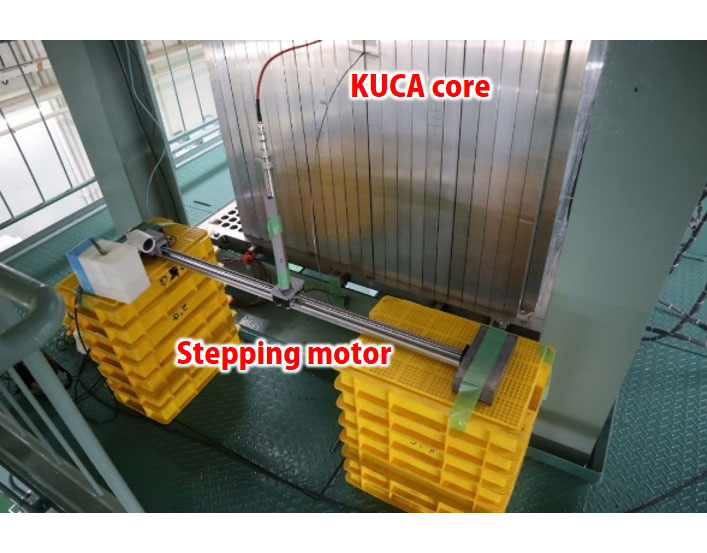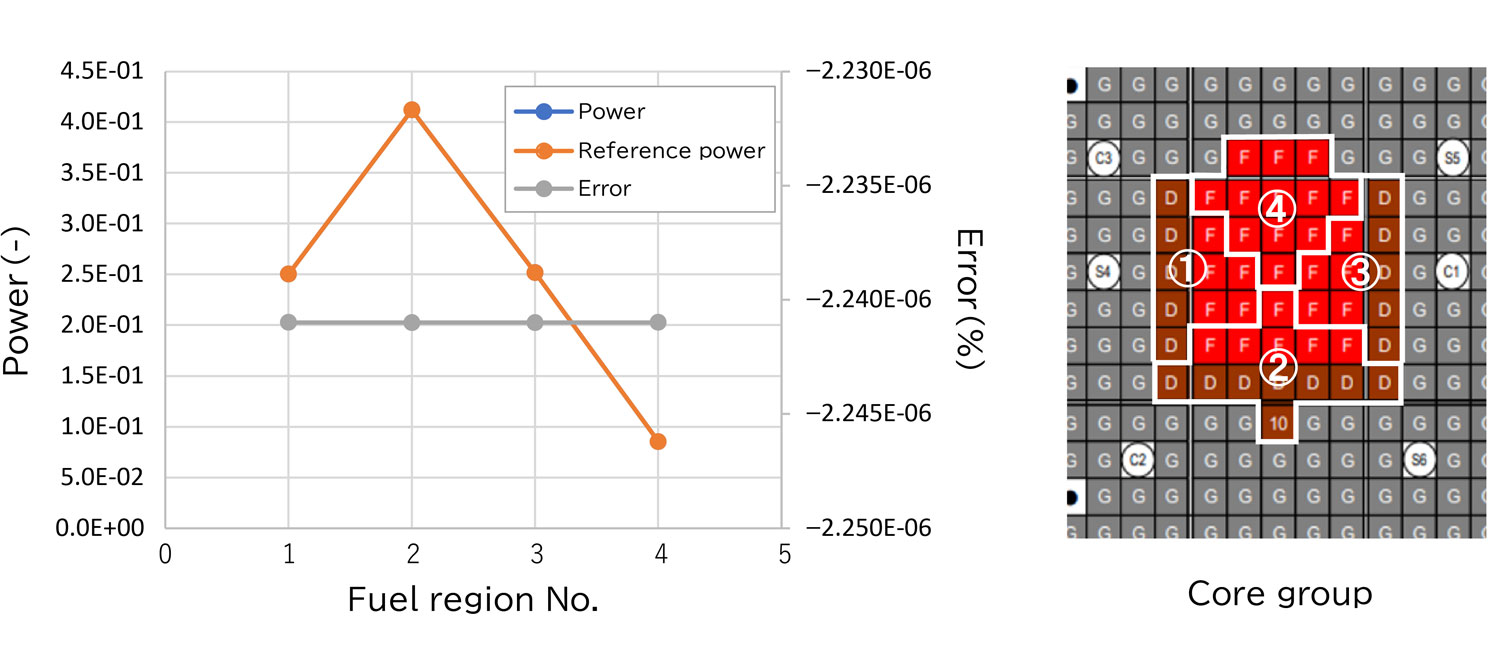 |
Topics
Completion of CT Principle-Based In-Core Power Distribution Measurement Technology
−Demonstration of Principle Through Critical Experiments−

Fig. 1 KUCA core and stepping motor
Detector acquires data around the core by changing the position of the stepping motor for each operation.

Fig. 2 Power and error of four groups of a core
Only four groups were available because information by height direction could not be obtained due to the stepping motor’s movement only for the horizontal direction. The accuracy is higher because a reference solution was used to average the sensitivity which needs power distribution. As a result, the reference power covers the power. The distribution is important for the power. Then, the power is normalized by the total power, and the power is dimensionless. Future work is needed on accuracy.
In the current light water reactors, it is possible to insert a neutron detector directly into the core, and the power distribution is measured by this method to manage the fuel in the core. On the other hand, it is difficult to insert a detector into the core of a high temperature gas-cooled reactor (HTGR), where the temperature inside the reactor can reach 1000 ℃ or higher.
Therefore, we devised to measure the power distribution by taking advantage of the graphite-moderated HTGR, which has a long neutron flight path. In this method, to obtain many measurement points, the detectors outside the reactor are moved, and the power distribution is measured by detecting the leaked neutrons from outside the reactor using the Computed Tomography (CT) principle. The usefulness of this idea was recognized, and in FY2021, the project was accepted by the Ministry of Education, Culture, Sports, Science and Technology of Japan (MEXT) for the "Development of Nuclear Instrumentation System for Power Distribution Measurement in High Temperature Gas-cooled Reactors" under the Innovative Nuclear Research and Development Program. The project was developed for practical use through industry-academia-government collaboration among JAEA, ANSeeN Inc. and Shizuoka University. This development will be completed in FY2024. During the development, ANSeeN Inc. and Shizuoka University's discussions led to the conclusion that the improvement of the HTTR output monitor's detector to move up and down would pose no technical challenges. For the technical demonstration of the principle, we also succeeded in reproducing the output distribution at KUCA, a critical assembly at the Institute for Integrated Radiation and Nuclear Science, Kyoto University (Figs.1 and 2).
Therefore, we devised to measure the power distribution by taking advantage of the graphite-moderated HTGR, which has a long neutron flight path. In this method, to obtain many measurement points, the detectors outside the reactor are moved, and the power distribution is measured by detecting the leaked neutrons from outside the reactor using the Computed Tomography (CT) principle. The usefulness of this idea was recognized, and in FY2021, the project was accepted by the Ministry of Education, Culture, Sports, Science and Technology of Japan (MEXT) for the "Development of Nuclear Instrumentation System for Power Distribution Measurement in High Temperature Gas-cooled Reactors" under the Innovative Nuclear Research and Development Program. The project was developed for practical use through industry-academia-government collaboration among JAEA, ANSeeN Inc. and Shizuoka University. This development will be completed in FY2024. During the development, ANSeeN Inc. and Shizuoka University's discussions led to the conclusion that the improvement of the HTTR output monitor's detector to move up and down would pose no technical challenges. For the technical demonstration of the principle, we also succeeded in reproducing the output distribution at KUCA, a critical assembly at the Institute for Integrated Radiation and Nuclear Science, Kyoto University (Figs.1 and 2).
Acknowledgements
This work was supported by MEXT Innovative Nuclear Research and Development Program Grant Number JPMXD0221459236.
Author (Researcher) Information
 | Name | Yuji Fukaya |
|---|---|
| HTGR Design Group, HTGR Project Management Office, Nuclear Energy Research and Development Domain |
Reference
March 31, 2025
HTGR Hydrogen and Heat Application Research
